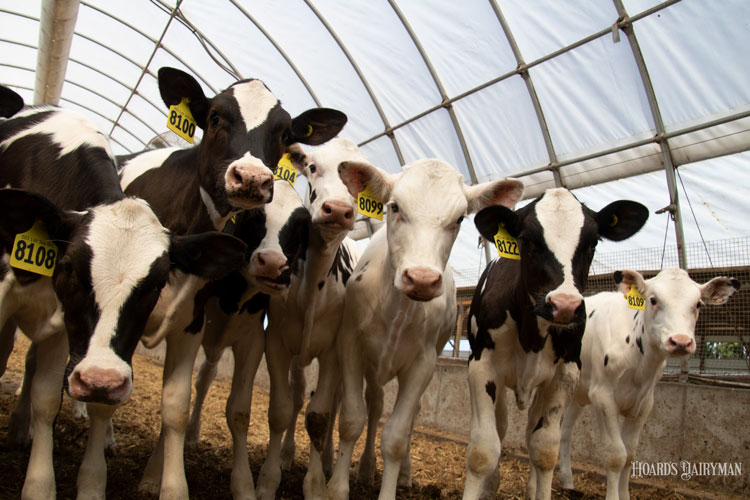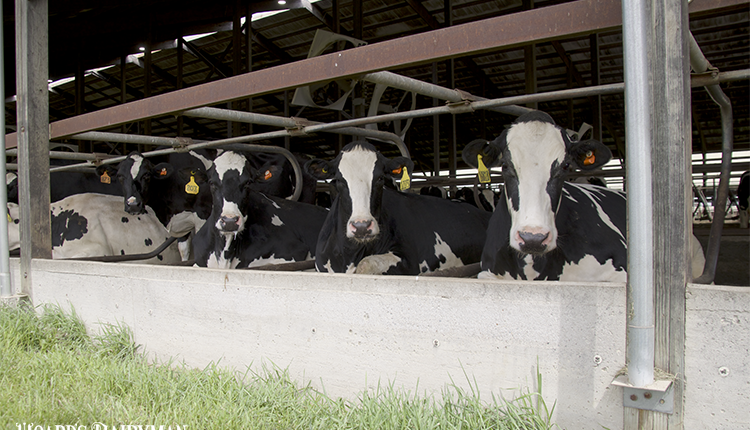
Dairy producers will soon have two new traits of significant economic value to consider in their breeding programs.
Feed Saved in Holsteins and Heifer Livability in both Holsteins and Jerseys will be launched by the Council on Dairy Cattle Breeding (CDCB). Feed Saved and Heifer Livability will be available as individual traits with the triannual genetic evaluations on December 1, and they are expected to be incorporated into the Net Merit genetic index when it is updated in 2021.
Improving heifer survival rates
Genetic progress has been ongoing to reduce cow deaths in milking herds through the Cow Livability and Productive Life traits. Now, Heifer Livability will support enhanced survival rates in young stock. An analysis of heifer records from herds on official Dairy Herd Information (DHI) testing showed 96% of heifers survive from two days to 18 months of age, the period for which Heifer Livability (HLIV) is based. The HLIV evaluation is expressed in percentage points above or below the breed average, with larger positive values being more favorable.
Heifer Livability reveals a heifer’s overall resistance to causes that lead to death, most commonly digestive and respiratory diseases (USDA APHIS, 2018). Improving heifer survival rates has clear benefit for producers, with the average cost of heifer loss estimated at $500 (Neupane et al, 2020).
Hay burners versus hay converters
Cows vary in the ability to convert feed to milk, and the Feed Saved trait will document those differences. Feed Saved will allow producers to breed for more feed-efficient cows, improve dairy sustainability, and save on feed costs, the largest expense item on most U.S. dairies.
While genetic selection for feed efficiency has been a long-time goal, it is difficult to measure and evaluate individual animals. Genomic tools and data technologies now allow us to identify and directly select for animals with that genetic advantage. The goal is to identify specific cows that eat less than expected while maintaining production and body condition.
Feed Saved is the first national evaluation in the U.S. to help dairy producers leverage genetic variation to develop a more feed-efficient herd. Feed Saved will be published as a single trait for Holsteins, and it is defined as the expected pounds of feed saved per lactation. Larger positive values represent more pounds of feed saved and indicate a more feed-efficient cow.
Feed efficiency has a heritability of approximately 14%, which falls midrange relative to other traits. Feed Saved will have low reliabilities at first, given the small number of reference cows with actual data on feed intake and related factors.
Measuring feed intake
To develop genomic evaluations, the necessary data — daily feed intake, milk yield, milk composition, body weight, and body condition score — must be measured for a genotyped reference population. This work has been a collaboration between CDCB, United States Department of Agriculture (USDA), and several universities.
Currently, a project to collect feed intake and sensor data on 3,600 Holstein cows is underway at Michigan State University, University of Wisconsin-Madison, Iowa State University, University of Florida, and the USDA Animal Genomics and Improvement Laboratory. This builds on earlier research that established a feed efficiency database of genotypes and phenotypes for 5,000 U.S. Holstein cows from multiple locations.
The initial Feed Saved evaluations are based on a reference population of more than 6,300 Holstein cows in research herds across the U.S. Adding data for more cows continues as a high priority and collaborative effort.
Learn more about Feed Saved
Feed Saved was the focus of the 6th annual CDCB industry meeting held virtually on November 2. Presentations by Kent Weigel, Paul VanRaden, Kristen Parker Gaddis, and Frank Mitloehner can be viewed on CDCB’s YouTube channel.
While the introduction of Feed Saved this December is an exciting milestone, researchers continue to seek ways to enhance the genetic selection tools, better understand genetics related to methane emission, improve dairy efficiency, and support the industry’s commitment to a reduced environmental footprint.
About Council on Dairy Cattle Breeding
CDCB drives global dairy cattle improvement by using a collaborative database to deliver state-of-the-art genetic merit and performance assessments for the herd decision making. The national cooperators database, the world’s largest database of genotypic and phenotypic data, is managed by the CDCB. The CDCB is a collaborative effort between four sectors of the U.S. dairy industry: Dairy Records Providers (DRP), Dairy Records Processing Centers (DRPC), National Association of Animal Breeders (NAAB), and Purebred Dairy Cattle Association (PDCA).
Read more about U.S. dairy improvement and CDCB initiatives in the 2020 CDCB Activity Report.








